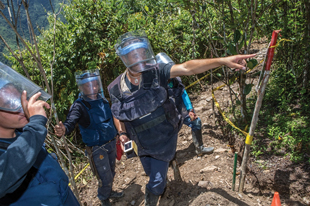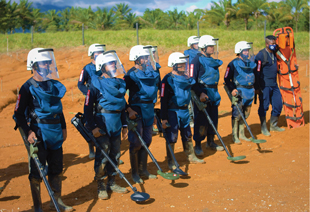Mine Action and the Reintegration of Former Combatants: Expanding the Debate
By Laurie Druelle [ Independent ], Henrique Garbino [ Swedish Defence University ] and Eric Mellado Åhlin [ Independent ] ¹
CISR JournalThis article is brought to you by the Center for International Stabilization and Recovery (CISR) from issue 25.3 of The Journal of Conventional Weapons Destruction available on the JMU Scholarly Commons and Issuu.com.
In the last decades, humanitarian mine action (HMA) and disarmament, demobilization, and reintegration (DDR)² processes have increasingly been recognized as essential to paving the way for sustainable development thanks to their contributions towards human security, livelihood, and access to services. The integration between the two processes, however, has not yet been fully addressed in the literature or practice. This paper seeks to identify areas where DDR and HMA intersect and, supported by anecdotal evidence, suggest a theoretical framework for future research and implementation. Most importantly, we hope to widen the debate on the potentially synergic relationship between HMA and DDR, flag possible fallacies or oversimplifications, and challenge solely “top-down” approaches.
Several institutions recognize the potential of the integration of HMA and DDR in contributing to broader peace and security objectives. Perhaps one of the earliest references comes from the Bad Honnef Framework in 1999, which explicitly stated that "mine action programs are part of peacebuilding programs. […], they should take into consideration the need for fully reintegrating refugees, displaced persons, and demobilized soldiers."3 A report from the United Nations Development Programme highlights that:
[…] ex-combatants can make good deminers, and that involving them in clearance operations can be a good interim arrangement on the road to reintegration into their communities and the local economy. Mine clearance situates ex-combatants in civilian life, but in a professional culture, with good remuneration and an opportunity for training in areas that can help them make the full transition to sustainable livelihoods. The participation of ex-combatants in demining operations can also help restore trust between former combatants and the community.4
However, while both processes aim at reducing armed violence and the impact of weapon contamination5 on human life, the link between HMA and DDR has not been explored sufficiently in the literature or practice. Indeed, recruitment of ex-combatants into mine action remains largely ad hoc and without clear “input to impact” correlation. The same observation can be made on the extent to which HMA genuinely contributes to DDR and other peace-building activities.
Mine Action and DDR: Synergies in Goals and Principles
In this paper, we regard DDR as a process through which former combatants, independently or as groups, voluntarily lay down their arms, break away from military command and control structures, and sustainably reintegrate as civilians in communities of their choice.6 In a traditional view of DDR, disarmament is primarily aimed at the weapons held by combatants, normally excluding humanitarian demining, explosive ordnance risk education (EORE), victim assistance, and advocacy from the DDR realm. However, the similarities between mine action programs and DDR processes are apparent:
- Both processes contribute to a decreased availability of weapons and munitions and are thus key in contributing to the security and de-militarization of society.7
- The return of productive areas advances the return to normalcy in terms of economic development and post-conflict reconstruction.8 Likewise, the reintegration of former combatants into formal employment can stimulate the local economy.9
- The work environment where demining often takes place, the organizational structures of many demining organizations, and many of the required skills for demining often resemble those of the military practice. Thus, the change from combatant to deminer does not represent much discontinuity for the combatant, facilitating a transition process.
- And, at last, the importance of community participation, engagement, and buy-in is central to both processes.10
Interestingly, the two processes have been described as being at the core of the humanitarian-development-peace (HDP) nexus. Alexander Zouev, UN Assistant Secretary-General for Rule of Law and Security Institutions, referred to mine action as "a vital element of the nexus between peace and security and development, and a cornerstone in preventing any relapse into future conflicts."11 Similarly, sustainable DDR processes are dependent on humanitarian and development programs, including demining initiatives, long-term development, and reform that address the root causes of the conflict and an improved security situation.12
In this light, closer linkages and strengthened synergies between HMA and DDR can, beyond their intrinsic value, be of benefit to the HDP nexus as a whole. The following subsections present an initial reflection on how this relationship potentially contributes to physical and human security, confidence building, employment, and community support.
Physical and Human Security

Jefferson Martinez, from FARC-EP, points out to members of the Colombian military’s Humanitarian Demining Brigade an area where they might find more landmines in a minefield in Antioquia, Colombia. Image courtesy of Norwegian People's Aid/Giovanni Diffidenti.
As increasingly recognized by several HMA donors, local-level human security13 should remain an essential outcome of HMA programming.14 It is also a key factor for DDR processes as a whole, particularly for sustainable reintegration. Security-related threats posed by armed forces, non-state armed groups, and criminal gangs are customarily addressed through disarmament and demobilization efforts, other initiatives aiming to reduce violence at the community level,15 stabilization efforts, and strengthening the rule of law. However, none of these initiatives address the security risks posed by landmines and explosive ordnance (EO). Different from the threat posed by small arms and light weapons, landmines and EO effectively deny community members access to productive land and vital infrastructure. Additionally, they stress local and often weak health structures through indiscriminate victimization and magnify related obstacles, preventing individuals from economic engagement and social participation in their communities.16
Furthermore, mines are often perceived as illegitimate weapons or invisible enemies that attack people without distinction and cause death or suffering for life, generating fear and resentment among the population, and enhancing collective trauma. As such, the clearance of mines has an intrinsic, symbolic value as it can represent the end of an otherwise endless anguish and protracted insecurity.17 Mine clearance can thus assist reintegration processes by contributing to the general sense of security at the community level, easing the traumas of conflict, and marking a symbolic milestone in conflict-to-peace transitions.
Confidence Building
The success of peace processes in general, and of DDR in particular, is dependent on the parties' buy-in to the process. However, individuals' and groups' commitment to these processes may be negatively affected by a lack of perceived or actual momentum, putting previously-made progress at risk. The clearance of landmines and other EO is an area where early agreement can be reached between conflicting parties, thereby presenting an opportunity for adversaries to credibly commit to a peace process and increase confidence.8 For example, in the aftermath of the Ecuadorian–Peruvian War19 or, more recently, in Colombia20 and the Korean Peninsula,21 humanitarian demining has been used to build trust between former or current enemy militaries. Moreover, in Colombia,22 Sri Lanka,23 Sudan,24 and Central America,25 community trust in former combatants was enhanced through humanitarian demining.
Once implementation starts, mine clearance can deliver tangible and concrete results relatively quickly, such as enabling the return of schools, hospitals, and productive areas to affected communities.26 Removing mines can thus bring much-needed momentum and public support to peace and reconciliation processes, transitional justice, and long-term development. In turn, these developments may be decisive motivating factors for former combatants to seriously commit to reintegration and for members of the recipient communities to accept the returning combatants and their associates.
In addition, access to productive land is central to most reintegration processes. As such, land dispute or animosity caused over the initial contamination of the land might spark distrust and a general feeling of betrayal among combatants and communities alike and, in turn, incentivize recidivism.
Mine action initiatives also provide examples of the potential role of non-governmental organizations (NGOs) as mediators between government authorities and former combatants. On 7 March 2015, before the signature of the peace agreement, representatives of the Colombian government and the Revolutionary Armed Forces of Colombia – People's Army (FARC-EP) signed the so-called "Demining Agreement."27 The agreement established a joint humanitarian demining project financed by the European Union (EU) and included the clearance of two hazardous areas. The project consisted of mixed technical teams from the Colombian Army and FARC-EP, coordinated and verified by Norwegian People's Aid (NPA).28 In addition, NPA acted as an independent, neutral, and impartial mediator and facilitator between the Colombian military and FARC-EP guerrilla fighters. The project was finally considered to have helped recover public confidence in the peace process and de-escalate the armed conflict,29 strengthening ties between the public forces and the FARC-EP and promoting a mediating role of NGOs between the signatories of the agreement.30 Similar solutions may be found in implementing integrated mine action and DDR projects.
Employment

Former FARC-EP combatants specialized in manual clearance technique and medical support of HUMANICEMOS DH, trained in December, 2020. Image courtesy of UNMAS Colombia and HUMANICEMOS DH.
Employment is commonly referred to as a mechanism that can mutually strengthen HMA and DDR.31 Mine action programs often provide several direct and indirect employment opportunities to conflict-affected communities. Intuitively, former combatants can bring significant contributions to mine action efforts, especially to its humanitarian demining pillar. It is not surprising then that many mine action organizations regularly employ former combatants in their country programs. Former combatants might have significant knowledge of the location of minefields, battle areas, and even ammunition caches and deposits.32 They can thus contribute to the identification of hazardous areas in non-technical surveys (NTS).33 Moreover, improvised explosive devices (IEDs) vary widely in design, technology, trigger mechanisms, components, and explosive yield, and former combatants' technical expertise and insights could be beneficial in conflicts with their widespread use. Accordingly, NPA experienced a considerable increase in efficiency using former combatants as guides in NTS for a pilot project in Colombia, from 1,500 to 400 sq m of cleared land for each mine or EO found.34
Humanitarian demining also reflects, to a large extent, the dynamics to which former combatants were accustomed during the conflict. HMA builds on hierarchical and disciplined structures working in challenging environments and managing potentially lethal EO.35 Apart from the familiarity with a hierarchical structure and adaptability to extreme environmental conditions (such as jungles, deserts, and mountains), many skills of former combatants are advantageous for demining work and are in high demand by demining organizations. For example, knowledge in EO recognition and safe handling of explosives, safety precautions, first aid, and cartographic techniques are basic military skills that are crucial to clearance activities.36
Former combatants that belong to communities affected by conflict may have a greater insight into, and access to, at-risk populations than what government and international actors do. This dynamic is further enhanced in regions where rebel groups were the de facto authorities or where civilians were victimized mainly by government actors. In turn, this proximity with the population becomes an advantage in gathering information during NTS, EORE activities,37 and community liaison, which is present throughout the land release process.38 The recruitment of former combatants by The HALO Trust (HALO) in Afghanistan, for example, allowed contact with previously inaccessible communities. HALO's program also benefited from the former combatants' technical and strategic knowledge and experience working in extreme environmental conditions.39
In a recent survey, virtually all former combatants working for HALO in Colombia reported personal satisfaction and increased living standards after joining the mine action organization. However, they valued the applicability of their previous experience as combatants to their new role as deminers differently. While some acknowledged the benefits of having worked with explosives and the know-how of living in the jungle and mountains, others deemed their previous experience as "totally useless" for clearance work.40 This highlights the need for proper training and accreditation of those engaging in demining initiatives, especially given that many members of armed groups fill supporting roles, such as informers or cooks, and therefore have less experience with explosives.
For former combatants, joining a mine action organization offers, above all, a dignified profession—besides not requiring formal education—with a good and sustainable income that is often respected by the community.41 In addition, it provides an opportunity to use their military knowledge while at the same time committing themselves to a positive and visible effort for affected communities and society at large.42 The change from combatant to deminer does not represent much discontinuity for the combatant while still forwarding the demobilization and reintegration processes and making them work for and with civilians.43 Engaging in humanitarian demining thus becomes a way for former combatants to overcome some hurdles preventing their reintegration.
In Afghanistan, former combatants were twice included in mine action programs, namely from 2004 to 2006, in the Mine Action for Peace (MAFP) project under the DDR process for pro-government militias partaking in the conflict against the Taliban; and the Afghanistan Peace and Reintegration Program (APRP) from 2010 to 2016.44 Both projects presented positive results regarding the acceptance of former combatants by the affected communities and the personal and professional satisfaction of the demobilized combatants.45 The retention rate among demobilized personnel in the mine action sector was 70 percent in 2012, without any of them having returned to the conflict.46
Community Support
Sustainable reintegration builds on the ability of former combatants to reintegrate as civilians, but it also requires a community that is receptive and able to absorb former combatants and their associates. Put differently, there has to be a community into which former combatants can reintegrate. In community-based reintegration, support is often directed towards communities with a high prevalence of former combatants. Thus, sustainable reintegration is facilitated through an enhanced socioeconomic and political capacity of these communities.47
In this light, humanitarian demining can play an important role in community-based reintegration. For instance, safe access to land is a significant benefit for the affected communities. It lays the foundation for agricultural development and employment, access to markets and critical infrastructure, and eases the burden of often stretched health systems. In addition, demining initiatives offer community members employment opportunities, providing essential economic injections that may transcend the community. Taken together, demining initiatives are exceptionally well placed to shape and connect former combatants and their associates with the recipient communities in which they reintegrate.
HMA as a Vector for DDR, but at What Cost?
As highlighted previously, some positive outcomes can be expected from better integration of DDR and HMA processes. However, capitalizing on these synergies without an adequate understanding of the complex environments and local power dynamics within which they are implemented can lead to more harm than good.
First, while most mine action operators put their humanitarian nature at the forefront, DDR processes are inherently political. For HMA operators to participate in, or be a component of, a DDR process could significantly challenge their impartiality and independence as they could be perceived as implementing the “winner's peace.” Furthermore, in mine action programs carried out or led by statutory military forces, the inclusion of former combatants from rebel movements may face resistance due to widespread distrust on both sides. On top of the usual operational risks related to HMA or DDR processes, these added components could fuel tensions further and amount to security concerns to the organizations, their staff, and the communities they are seeking to support.
Second, the employment of former combatants can create the perception of injustice for benefiting them with sustainable jobs while the population continues to suffer the consequences of the conflict. This perception is reinforced by the narrative of former combatants first having planted the mines and then being paid to remove them. A similar perception occurred in South Africa in the 1990s when companies producing anti-personnel mines began to work with humanitarian demining.48
Third, integrating former combatants into mine action could also come at the expense of other members of the local society. At a time when mine action operators dedicate many resources to improve gender balance in their teams, the employment of primarily male former combatants in demining initiatives includes significant risk of reinforcing gender inequalities. HMA organizations should remain accountable to the local population they seek to assist and inform their recruitment processes based on thorough assessments of local power dynamics; different gender, age, and diversity needs; and barriers to access. This would ensure that no harm is done in awarding comparatively higher income to some sub-groups of the society. To avoid worsening disbalance in power dynamics, operators could dedicate efforts to connect their work with humanitarian and development actors so that members of the society who will not benefit from employment opportunities or land release are also supported.
Finally, another challenge identified in closer DDR-HMA integration is funding. On the one hand, there is pressure for comprehensive programs that integrate both mine action49 and DDR50 into the HDP nexus. As such, a single project that works simultaneously with both issues could increase the cost-benefit ratio perception to prospective donors. For these reasons, we assume that the international community and donors would receive the proposal for an integrated HMA-DDR program well. For instance, in Afghanistan, HALO's integrated project under the APRP gained interest and support from donors such as Japan and Germany.51 Similarly and most recently in Colombia, HUMANICEMOS DH52—the first and only mine action organization established, staffed, and run solely by former combatants—received plenty of donor attention, especially from the EU and the UN–managed, multi-donor trust funds.53 However, while some donors might be willing to support former combatants, others might face political, financial, and legal barriers for doing so.
The Colombian case again provides an interesting example. The EU and the UN are the main donors for HUMANICEMOS DH, which employs only former FARC-EP combatants. In contrast with other donors, until recently, the United States had been unable to fund any project where former FARC-EP combatants took part. In turn, this led to a significant obstacle for the organization, whose demining operations were stalled until October 2020.54 The mine action accreditation authority in Colombia, the Organization of American States' (OAS) mine action program, is mainly funded by the United States and could not accredit former combatants for demining tasks.55 The solution was to delegate the responsibility for accreditation and quality management of HUMANICEMOS DH to the United Nations Mine Action Service (UNMAS) in Colombia.56 Following this arrangement, HUMANICEMOS DH became operational in October 2020 and has not stopped since. They even delivered their first mine-free area in October 2021. In November 2021, in the framework of the fifth anniversary of the Peace Accord, the United States removed the FARC-EP from the list of terrorist organizations, which allows HUMANICEMOS DH to be considered for technical assistance and resources from the United States and other international organizations such as the OAS.57
This serves as an illustrative example of the political complexities of joining the nodes of the HMA-DDR nexus, especially within the funding realm. Once again, underlining how the intersection between these two fields—despite being closely related—is far from clear cut. However, overcoming these challenges has great potential, as stated in a recent UNMAS report:
HUMANICEMOS DH as an organization has made reintegration possible through mine action in Colombia and as a consequence, it is expected that there will be effective actions of reparation with the communities affected by the armed conflict. The Humanicemos Reintegration Project shows that the main contribution of mine action to effective collective and individual reintegration is the professional and personal work-related development of the ex-combatants. The Project has fostered decent employment with reasonable salaries and benefits, formal and informal training courses, and, to a lesser extent, treatment of the psychosocial issues of ex-combatants, from a holistic approach. In this way, the ex-combatants currently linked to the Project as well as those ex-participants that were previously trained and employed in the sector have been discouraged from re-joining armed groups by relying on the skills, technical tools and legitimate resources in their transition and continuance in civilian life.58
Conclusion
Throughout this article, we discussed the nexus between two fundamental processes at the core of the humanitarian-development-peacebuilding nexus: HMA and DDR. We highlighted possible pathways through which an integrated approach could benefit the nexus at large as well as mine action and DDR processes in particular. We have also discussed the challenges and identified possible solutions. In doing so, we aimed to contribute to a theoretical framework that, we hope, may be helpful for future research and to widen the debate on this still underexplored facet of conflict and post-conflict environments.
We encourage future research and cooperation between stakeholders, from think tanks and academia to government bodies and international organizations to NGOs and civil society organizations. In particular, we encourage operators to continue documenting their work on the matter, not solely quantitatively but also qualitatively and at the outcome level, including adverse and unforeseen ripple effects on local power dynamics induced from the employment of former combatants in mine action programs. We also encourage donors to continue to play a role in keeping their partners accountable and challenge oversimplifications, for example, that employment equals development. Finally, all external actors working along with the HDP nexus are responsible to maintain a people-first approach and a light footprint on local dynamics. ◊
 Laurie Druelle
Laurie Druelle
Independent
Laurie Druelle has worked at the field and HQ levels in humanitarian mine action and armed violence reduction organizations such as Humanity & Inclusion, The HALO Trust, and the Danish Refugee Council since 2016. Druelle holds an MA in Conflict, Security & Development from the War Studies Department of King's College London (2015) and a BSc in International Studies focusing on war to peace transitions from the University of Montreal (2013). Having delivered work in a dozen mine-impacted countries, Druelle specializes in developing more inclusive, participative, and conflict-sensitive programming and creating partnerships with non-HMA experts from the peacebuilding and development sectors. Druelle has contributed to this paper in her own capacity, and expressions might not represent the views of her employer.
 Henrique Siniciato Terra Garbino
Henrique Siniciato Terra Garbino
Swedish Defence University
Henrique Garbino is a Doctoral Candidate at the Swedish Defence University (2021–present). He holds a BSc in Military Sciences from the Military Academy of Agulhas Negras (2010) and an MSSc in Peace and Conflict Studies from Uppsala University (2019). He served in the Brazilian Army as a combat engineer officer (2006–2017); supported the mine action programs in Tajikistan and Ukraine, as well as the reintegration process in Colombia as a Rotary Peace Fellow (2018–2019); and deployed as Weapon Contamination Delegate for the International Committee of the Red Cross in Eastern Ukraine (2019–2020; 2022).
 Eric Mellado Åhlin
Eric Mellado Åhlin
Independent
Eric Mellado Åhlin is a DDR Policy Officer at the European External Action Service (2021–present). He holds an MA in International Political Economy from King's College London (2017) and a BA in Peace and Conflict Studies from Uppsala University (2014). Mellado Åhlin has previous experience from the Swedish Folke Bernadotte Academy (2014–2021), where he supported DDR processes in Myanmar and Colombia and contributed to training and other capacity-enhancing initiatives. Mellado Åhlin has contributed to this paper in his own capacity, and expressions might not represent the views of his current nor previous employers.

